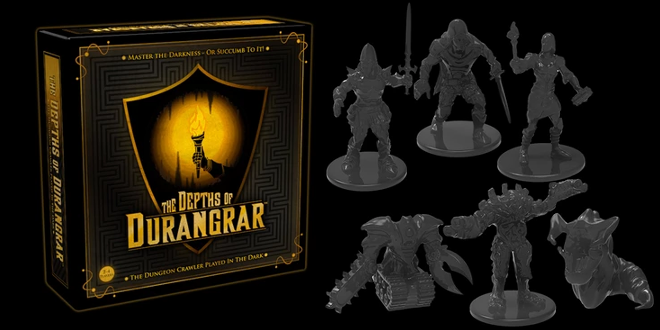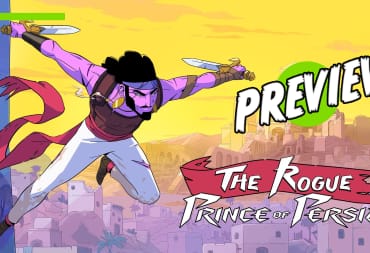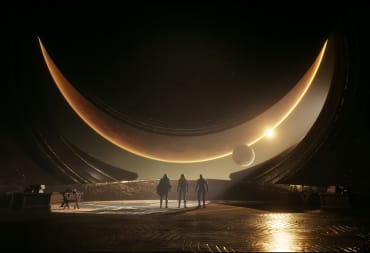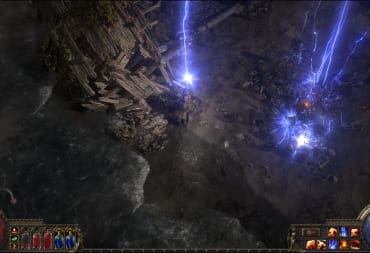It's a dark and stormy night. The power has gone out. Your phones are dying, and the family is sitting around with not a whole lot to do. You could break out a copy of Monopoly and start a fight over who owes who rent. Alternatively, you could play a game of The Depths of Durangrar, a dungeon crawling board game that's played in the dark.
The Depths of Durangrar (developed by Creative Cove Games) was one of the many games I discovered via a Playcrafting Expo. A man by the name of Jack Poon was sitting behind a small table with a large black shroud over it. He explained his game to me, and I was sent a prototype copy with plenty of time to preview it. (As an aside, I interviewed Jack Poon last year and you can discover some of his philosophy behind the game's design in that article.)
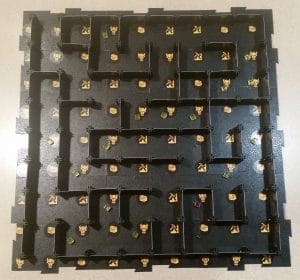
The Depths of Durangrar is an asymmetrical game in many respects. One player is the "Monster" who is equipped with provided night vision goggles—this allows him to see everyone's positioning on the board. Everyone else is an"Explorer." The Explorers are represented by miniature figures with LED lamps on their base, which ensure that you can only see forward and a few tiles ahead of you. The Explorers might occasionally work together, but ultimately they are playing against each other. The Monster is playing against all of the Explorers and is appropriately powerful to accomplish the task—if you set him up right.
The game begins with a fair bit of setup. Indeed, your first time through, it will probably take you a half hour to set the game up. You can speed things up once you know what you're doing, but in honesty The Depths of Durangrar is not an ideal game if you only have about an hour to play. It is, however, a fantastic way to spend an evening in my opinion.
The entire board is a modular maze that you build, and the creation of this maze is the responsibility of the Monster player.. You can place the nine provided floor tiles together in any configuration you like (and you can leave some of them out if you felt so inclined). Pegs are inserted into holes on the tiles, and then walls are slotted in-between the pegs to form the maze's layout.
The maze's configuration has some basic rules. All loot must be accessible so you can't just stick all of the treasure behind a series of completely enclosed rooms. Players must be able to path to any placed loot as well as both The Camp (the player's spawn point) and The Den (the monster's spawn point). Other than that, you can build the maze however you like. One idea floated to me by the developer was making a rather large open "Mines of Moria" style map with a bunch of pillars everywhere. This allows for a lot of freedom and replayability as players won't quite know what to expect when they're playing the game.
After the maze's configuration is set up, the Monster player must place the Gold in the maze. Gold is represented by a series of acrylic tokens in 100, 500, and 1,000 Gold denominations. The clear acrylic lights up magnificently when one of the player's lanterns happens upon it and makes them very easy to notice once a player has established a line of sight.
The amount of Gold placed in the maze is based on the length of a game. A one hour game, for instance, requires that you place 1,000 Gold in the maze. A two hour game requires 2,000, and so on. The Gold amount is also the victory condition for the Explorers—the first Explorer to successfully bank that amount of Gold wins the game. The Monster has to rack up a certain number of player deaths that is similarly balanced (three deaths for one hour, four deaths for two hour, etc.). To add to the peril, any player death adds to the Monster's score whether it's from PvE, PvP, a trap, or a dice roll gone bad. The only stipulation for the Monster is that they must make the last Explorer kill themselves to win. This prevents the game from ending on a sour note because an Explorer happened to die to an unfortunate roll of the dice.
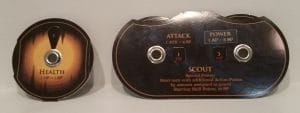
The Monster has to set up the maze and lay out the loot without the knowledge of the Explorers. It's best to use this time for the Explorers to select their characters and set up their stats. The Monsters and Explorers can customize their characters on three different stats using a point-buy system. The Explorers, for instance, spend 16 Skill Points between Health (one SP each), Attack (two SP each), and their Special Ability (varying SP depending on the class).
The Demolitionist Explorer can spend one SP to get the ability to knock down two walls without the use of the TNT item. I once played this particular class by spending zero points in attack and five points in my Special. I demolished a path straight through the middle of the maze, and although my plan was to escape to The Camp and respec my character, I unfortunately was killed in the darkness by the Monster.
The Scout's Special Ability is additional Action Points for three Skill Points apiece. Normally, the Explorers get a static six Action Points, which are used for picking up loot, turning their miniature, attacking, or moving. The Scout can sacrifice their Attack and Health to be much more mobile. Indeed, one player in my playtesting group elected to have eight Action Points that rendered them highly mobile. You don't have to fight if you can outrun everyone!
Lastly, the Knight's Special Ability is Damage Reduction. For every three Skill Points spent, the Knight gains a passive damage reduction for that amount. Six Skill Points will result in all damage being reduced by two points. Anyone who takes damage (be it the Monster or the Player) will always sustain at least one point of Damage.
The Monster can be similarly customized. The Monster is a bit stronger than the Explorers as they absolutely will have to contend with multiple opponents. Monsters get 32 Skill Points to distribute between Health (one SP each), Attack (two SP each), and Action Points (three SP each). Every time the Monster is killed it gains an additional three Skill Points added to its pool. However, a slain Monster also drops 1,000 Gold on the spot it died and the Monster player must distribute an additional 1,000 Gold throughout the maze on valid tiles. This makes playing a glass cannon an untenable strategy that will lead to a quick loss as players will waltz out of the maze with armfuls of treasure.
There are three different Monsters to choose from in The Depths of Durangrar. The Excavator can place a temporary wall anywhere in the maze for an AP cost. The wall can be demolished through normal means or simply attacked by players to be destroyed. The Thresher can leap over walls at the cost of two AP—this lends well to designing mazes that are difficult to walk through but can easily be cut short by leaping over walls. Lastly, the Sentient Fungus gets special environmental tiles, such as a tar that costs an additional AP to move through or a poisonous gas that damages a player for one HP if they end their turn on it. The Monster player can switch between the different Monsters after they die or at will if they walk back to their Den, and any laid traps or temporary walls remain on the map. This allows for switching between monsters to set up different strategies.

Once the maze has been set up and everyone has set up their characters, it's time for the lights to go out. As the Monster is the only one who is supposed to see the map, I've found it helpful to cover the maze up with a towel after building it so everyone can double-check their setup while the light is still on. When you're ready to go, a series of LED clip on lights are placed on the character screens, the box (for rolling dice), and the loot tray. The lanterns on the player's miniatures are turned on, and the lights go out.
You might be wondering how exactly the Monster is able to see in the dark. This is accomplished by way of an included night vision scope. The scope provided with the prototype preview copy was an off-the-shelf solution that won't necessarily be in the final box, but it worked quite well. As the Monster, I wasn't really able to read text on the player screens, but that's why everyone, Monster player included, is provided with clip-on lights for the screens. The important thing is to be able to see the maze and the position of everyone, and the night vision scope allowed for that to be accomplished admirably. The Depths of Durangrar is a game of information asymmetry, and the Monster player has all the information about the board whereas Explorers only know what their lanterns tell them.
The game itself begins with the Explorers standing outside the maze at The Camp, and the Monster standing on the opposite side of the board in The Den. Explorers roll a die to determine who goes first, and after all Explorers complete their turn, the Monster is able to move. Explorers will move through the maze trying to collect Gold and make it back out to The Camp to bank it towards their score. The Monster will try to kill the players to meet their victory condition of Explorer deaths while simultaneously trying to avoid their own death.
The Monster itself would be enough of a hazard if it weren't for the events spelled out on the maze's floor. Each "square" of the maze has a circular symbol with a different event on it. Explorers have to deal with the event on the tile that they end their turn on. The Looting Event allows Explorers to roll the Loot Die that might reward them with power-ups that do additional damage or restore life. The Mining Event allows Explorers to acquire 100 Gold by a successful roll of the Mining Die without having to find it in the maze. The previous two events are optional and have some degree of hazards in them, but the Ambush event is mandatory. The red Ambush die must be rolled, and it can result in losing money, losing life, choosing between either, or no harm whatsoever.

The dice are rolled in the lid of the box, which is mildly illuminated by a similar clip-on LED similar to the ones provided for the player screens. We played our games in near-total darkness, and it was easy enough to make out what a die had landed on. If for some reason you can't see it, you could always pick the die up and check it underneath the clip-on LED on your player screen. This would, of course, require some degree of trust between players not to cheat. There's nothing different here compared to any other board game as they all rely on the people to play fair.
The different events represented on the maze's floor can be used to further shape the flow of a maze. A strategy I was particularly fond of as the Monster was making dead-end corridors that had two or three Ambush events in a row and a pile of Gold at the end. Players were more likely to land on an Ambush and suffer additional damage trying to get to the Gold. If they attempted to wait for their next turn to maximize their movement abilities, that worked out just fine—it gave me more time to sneak up behind them!
As Explorers progress through the maze they will encounter Gold placed by the monster. You can place any amount of Gold on any tile during setup. Regardless of the amount, it costs players one AP to pick up or drop Gold per 500 Gold. Additionally, each 500 Gold a player is carrying reduces their max AP by one. This means that a player carrying 1,500 Gold will only have three AP instead of six AP and effectively be able to move half as quickly.
The meta that evolved was mostly using 100 Gold tokens throughout the maze to maximize the amount of time it would take players to build up any significant amount of money. There were plenty of yellow 100 Gold cubes, purple 500 Gold cubes, and red 1,000 Gold gems provided for normal gameplay. However, in light of this strategy I felt that there should more 100 Gold tokens included with the game as we occasionally risked running low.
One might think that The Depths of Durangrar is "The Explorers vs. The Monster," but it is actually "The Explorers vs. The Explorers vs. The Monster." Only one player can win, and the players must carefully balance their choices between grouping up together to survive or letting another Explorer walk off with the winning amount of Gold. When either the Monster or an Explorer dies, they drop everything they were carrying on the space they were occupying—a fortuitous betrayal executed at just the right moment can steal victory away from an unwary Explorer. However, if the Explorers are too stab-happy, they will only serve to rack up more Explorer Deaths towards The Monster's victory condition.
Combat is executed through a series of dice rolls. The instigating player rolls the Black die and the defending player rolls the Blue die. The result can be full damage, one HP of damage, evasion, or a "miss," which results in the dice being swapped in a counter-attack sort of rule. It takes one AP to attack, so a player standing still with someone else on their tile could get six (or more!) attacks in one turn. However, RNG is as cruel a mistress as she ever was, and I saw more than a few turns where an Explorer or the Monster somehow managed to survive an entire turn's worth of attacks. There's no guarantees in The Depths of Durangrar.
My playtesting group played around a dozen games of The Depths of Durangrar in various configurations. Everyone got a turn to play each of the different roles, and we all generally had a good bit of fun. That's not to say that The Depths of Durangrar was wholly without problems.
The prototype copy of the game I was provided with had 3D printed figurines as manufacturing hadn't yet started. The Scout figure had at one point separated from his lantern stand. The developer kindly offered to send me a replacement, but I politely declined as it was an easy fix for me to do.
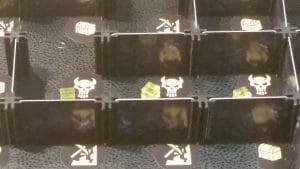
The board assembly was also a bit of a pain at times, but again these were not representative of the production model. The floor pieces snap together like a jigsaw puzzle, and sometimes they just wouldn't lock up neatly. I also occasionally had trouble getting the wall pegs into place, but these were 3D printed and hand-filed, so they weren't up to production quality, either. Still, for the most part we had few issues with the physical pieces of the prototype copy as they were. I've been told that the production copy will be produced to a higher quality standard, and while I haven't seen it firsthand, I imagine that these issues will not be as much of a problem in the final product.
The rules themselves also presented a few problems. Mainly, it was a whole bunch of minor clarifications that were necessary. I want to emphasize how patient and helpful Jack Poon of Creative Cove Games was in responding to my e-mails and answering my questions. The end result was around two pages of errata that either corrected or clarified issues that weren't specified in the rulebook I was provided. For instance, one of my many questions was whether or not players had to rotate their miniature to navigate turns (which costs one AP for Explorers only, the Monster can rotate at no AP cost). I was told that they could elect to strafe or backpedal entirely if they desired. All of these specifics about rules and possible gameplay scenarios will hopefully be included in the final rule book. The rule book itself was 18 full-size pages, and it's understandable that there would be a few things that wouldn't have come up without a fresh pair of eyes on them.
We've also found that the two-hour game ruleset (Explorers must reach 2,000 Gold or the Monster much reach four Explorer Deaths) was probably the best middle ground. A "one hour" game option is available, but it personally felt a bit too short considering the 20-30 minutes it takes to unpack and set up the game board. The Depths of Durangrar is best used as a game you will play over several hours rather than something you set up quickly and play in a short amount of time. Still, it's quite nice that there are a variety of different gameplay lengths outlined in the rules. There's a five hour variant of the game if you feel like spending an entire evening playing, and I'm sure that the existing time limits could be used to extrapolate something longer if players felt so inclined as to come up with a house rule.
All in all, the issues that I had with The Depths of Durangrar were relatively minor compared to the product as a whole. By and large the game was balanced and well-designed. And most importantly, it was fun. I had a moment of absolute glee as the Monster when one of the Explorers rotated around only to see my Thresher standing right behind them—the matte-painted Monster figurines are practically invisible in the dark. I felt like the terror in the dark in any slasher movie of your choice and it was an absolute riot.
I really liked The Depths of Durangrar, and they've just launched their Kickstarter on April 19th, 2016. A pledge of $80 (plus shipping) will net you a boxed copy of the game, and considering the modular nature of the board as well as the lights & night vision scope, I feel that this is a fair price. The quality and cost of the components aside, if this seems like the kind of game you would like I think that you'll get a lot of replay value out of it.
The copy of The Depths of Durangrar used for this preview was provided by Creative Cove Games.
Update: The price of the game was changed between publication and launch of the Kickstarter. The article has been updated to reflect the accurate pricing.
What do you think of the idea of a board game played in the dark? Does The Depths of Durangrar sound like an interesting game to you? Let us know in the comments below!
Previews you can trust: To ensure you're getting a fair, accurate, and informed review, our experienced team spends a significant amount of time on everything we preview. Read more about how we review games and products.
Have a tip, or want to point out something we missed? Leave a Comment or e-mail us at tips@techraptor.net
